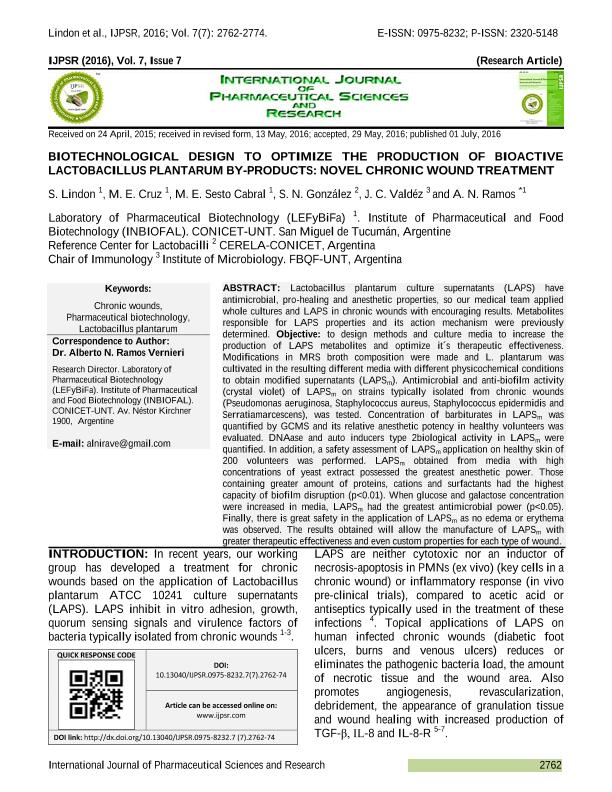Mostrar el registro sencillo del ítem
dc.contributor.author
Lindon, Silvana
dc.contributor.author
Cruz, María Elena
dc.contributor.author
Sesto Cabral, María Eugenia

dc.contributor.author
Gonzalez, Silvia Nelina

dc.contributor.author
Valdéz, Juan Carlos

dc.contributor.author
Ramos Vernieri, Alberto Nicolás

dc.date.available
2020-08-25T19:59:31Z
dc.date.issued
2016-07-01
dc.identifier.citation
Lindon, Silvana; Cruz, María Elena; Sesto Cabral, María Eugenia; Gonzalez, Silvia Nelina; Valdéz, Juan Carlos; et al.; Biotechnological design to optimize the production of bioactive lactobacillus plantarum by-products: novel chronic wound treatment; Society of Pharmaceutical Sciences and Research; International Journal of Pharmaceutical Science and research; 7; 7; 1-7-2016; 2762-2774
dc.identifier.issn
2320-5148
dc.identifier.uri
http://hdl.handle.net/11336/112392
dc.description.abstract
Lactobacillus plantarum culture supernatants (LAPS) have antimicrobial, pro‐healing and anesthetic properties, so our medical team applied whole cultures and LAPS in chronic wounds with encouraging results. Metabolites responsible for LAPS properties and its action mechanism were previously determined. Objective: to design methods and culture media to increase the production of LAPS metabolites and optimize it´s therapeutic effectiveness. Modifications in MRS broth composition were made and L. plantarum was cultivated in the resulting different media with different physicochemical conditions to obtain modified supernatants (LAPSm). Antimicrobial and anti-biofilm activity (crystal violet) of LAPSm on strains typically isolated from chronic wounds (Pseudomonas aeruginosa, Staphylococcus aureus, Staphylococcus epidermidis and Serratiamarcescens), was tested. Concentration of barbiturates in LAPSm was quantified by GCMS and its relative anesthetic potency in healthy volunteers was evaluated. DNAase and auto inducers type 2biological activity in LAPSm were quantified. In addition, a safety assessment of LAPSm application on healthy skin of 200 volunteers was performed. LAPSm obtained from media with high concentrations of yeast extract possessed the greatest anesthetic power. Those containing greater amount of proteins, cations and surfactants had the highest capacity of biofilm disruption (p<0.01). When glucose and galactose concentration were increased in media, LAPSm had the greatest antimicrobial power (p<0.05). Finally, there is great safety in the application of LAPSm as no edema or erythema was observed. The results obtained will allow the manufacture of LAPSm with greater therapeutic effectiveness and even custom properties for each type of wound.
dc.format
application/pdf
dc.language.iso
eng
dc.publisher
Society of Pharmaceutical Sciences and Research
dc.rights
info:eu-repo/semantics/openAccess
dc.rights.uri
https://creativecommons.org/licenses/by-nc-sa/2.5/ar/
dc.subject
LACTOBACILLUS PLANTARUM
dc.subject
BY-PRODUCTS
dc.subject
BIOTECNOLOGICAL DESIGN
dc.subject
CHRONIC WOUND TREATMENT
dc.subject.classification
Medicina Integral y Complementaria

dc.subject.classification
Medicina Clínica

dc.subject.classification
CIENCIAS MÉDICAS Y DE LA SALUD

dc.title
Biotechnological design to optimize the production of bioactive lactobacillus plantarum by-products: novel chronic wound treatment
dc.type
info:eu-repo/semantics/article
dc.type
info:ar-repo/semantics/artículo
dc.type
info:eu-repo/semantics/publishedVersion
dc.date.updated
2020-05-04T15:14:43Z
dc.identifier.eissn
0975-8232
dc.journal.volume
7
dc.journal.number
7
dc.journal.pagination
2762-2774
dc.journal.pais
India

dc.journal.ciudad
Nueva Delhi
dc.description.fil
Fil: Lindon, Silvana. Universidad Nacional de Tucumán. Facultad de Bioquímica, Química y Farmacia; Argentina
dc.description.fil
Fil: Cruz, María Elena. Universidad Nacional de Tucumán. Facultad de Bioquímica, Química y Farmacia; Argentina
dc.description.fil
Fil: Sesto Cabral, María Eugenia. Universidad Nacional de Tucumán. Facultad de Bioquímica, Química y Farmacia; Argentina
dc.description.fil
Fil: Gonzalez, Silvia Nelina. Universidad Nacional de Tucumán. Facultad de Bioquímica, Química y Farmacia; Argentina. Consejo Nacional de Investigaciones Científicas y Técnicas. Centro Científico Tecnológico Conicet - Tucumán. Centro de Referencia para Lactobacilos; Argentina
dc.description.fil
Fil: Valdéz, Juan Carlos. Universidad Nacional de Tucumán. Facultad de Bioquímica, Química y Farmacia; Argentina
dc.description.fil
Fil: Ramos Vernieri, Alberto Nicolás. Universidad Nacional de Tucumán. Facultad de Bioquímica, Química y Farmacia; Argentina
dc.journal.title
International Journal of Pharmaceutical Science and research
dc.relation.alternativeid
info:eu-repo/semantics/altIdentifier/doi/http://dx.doi.org/10.13040/IJPSR.0975-8232.7(7).2762-74
dc.relation.alternativeid
info:eu-repo/semantics/altIdentifier/url/https://ijpsr.com/bft-article/biotechnological-design-to-optimize-the-production-of-bioactive-lactobacillus-plantarum-by-products-novel-chronic-wound-treatment/
Archivos asociados
